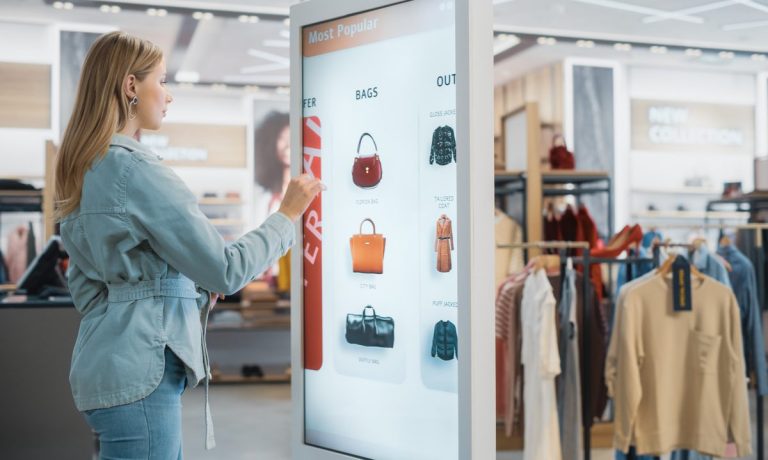
In-store media opportunities are making a comeback, but this time with a little more zest than before — interactive displays, as brands and retailers look to attract more consumers, who are increasingly making their way back to in-store experiences.
Despite the significant investments made in online retail media networks in recent years, brick-and-mortar stores remain the primary source of revenue for many retailers. In fact, more than 85% of all U.S. retail sales still occur in the physical world, not online.
Furthermore, these sales are considered much more qualified as consumers have more opportunities to engage with a product and are less likely to return it. This finding became more apparent during the pandemic, when eCommerce sales dramatically increased, encouraging adoption of online shopping but also leading to increased returns. According to DHL, eCommerce jumped to $26.7 trillion in 2020, accounting for 19% of global retail sales. Additionally, they found that online returns jumped from 10% in the U.S. in January 2020 to 18% in January 2021.
So, as brands and retailers look to in-store media opportunities, a $100 billion industry that accounts for 18% of all digital ad spend around the world, several technology firms, including Microsoft and Cooler Screens, and retailers like Walmart and Amazon, are launching their own solutions to facilitate brand advertising within physical stores. However, these features are stil in their early stages of development, and in-store retail media offerings have yet to achieve the same level of success as digital retail media solutions.
In January, Microsoft introduced a proof of concept called PromoteIQ In-Store which aims to help retailers as they experiment with content and hardware partners to create in-store retail media activations and digital signages. Microsoft expects the Promote IQ In-Store feature to be available in the next year.
On the other hand, Amazon, which reportedly generates roughly $31 billion a year from its advertising business, launched its own digital media opportunity in October 2022 at Amazon Fresh stores. Amazon then allowed companies to use Amazon demand side platform (DSP) to broadcast advertisements in stores. Similarly, in 2021, Walmart started selling ad space on its in-store checkout and display screens to reach consumers in stores.
Walmart Connect, the advertising arm of Walmart, has reportedly seen over 40% growth during Q4 and has a significant opportunity to leverage in-store retail media formats with its 4,700 stores in the U.S.
According to Rich Lehrfeld, senior vice president and general manager at Walmart Connect, during a virtual summit March 3, the majority of sales happen in-store, making it crucial for Walmart to have value propositions that can reach customers in that mode.
To enhance the in-store experience, Walmart is developing new ways to engage with consumers, such as demos, events, and interactive in-store screens. However, the focus is on creating a customer-centric experience rather than simply displaying more advertisements. Lehrfeld believes that the in-store experience holds incredible growth potential.
Generally, when people walk into the store, they have an idea of what they want, but they may not be aware of the options they have available to them. This is where interactive in-store media can come into play.
By using interactive displays, customers can input their preferences, discover new products, and sign up for loyalty rewards. Brands can also use these displays to offer customers relevant and personalized offers.
Integrating targeted advertising with in-store interactive screens can significantly enhance a brand’s media effectiveness and provide a new revenue stream for retailers. The proximity of advertising to the point of purchase creates a virtuous loop that allows brands to quickly understand which aspects of their campaigns are successful and adjust as needed.
Retailers can then use this information to determine which customer segments respond better to certain brands, enabling them to fine-tune their monetization strategies. Customers benefit from better product matches and more relevant offers, leading to more qualified purchases and fewer returns. Overall, the integration of interactive in-store media offers a win-win situation for both retailers and shoppers.
Interactive displays present brands with an opportunity to reach audiences at scale, in-store, allowing them to gain awareness of the brand and product first-hand, touch the product and then purchase at checkout. Interactive displays enable brands to double down on an opportunity that gives consumers the immediate gratification of purchasing a product after seeing it.
As PYMNTS mentioned on Monday, brands must consider retailer distribution as a growth channel rather than rely solely on it for its success.
Merely securing a partnership with a retailer does not guarantee sales and profits. To use this channel effectively, brands must consistently promote the relationship to their audiences, informing them of more ways to gain access to these products.
While traditional advertising experiences such as store shelves, end caps, and checkout displays can raise awareness, they are not as effective at driving engagement or conversion. This is where interactive screens can revolutionize in-store advertising. However, the development and deployment of such screens require technical expertise and a significant infrastructure investment. Hence, many retailers are still in the early stages of rolling out their retail media offerings.
One of the major challenges in creating in-store retail media networks is collecting relevant data from stores to optimize the ad ecosystem. The fragmented technology landscape also poses difficulties in planning and executing campaigns. Additionally, the high cost of deploying in-store digital signage is a barrier to entry.
Despite these challenges, some in-store media placements have already been launched. However, the question of attribution and the ability to demonstrate the effectiveness of these placements by linking purchase data to campaign exposure data remains a significant challenge. This linkage can provide a more accurate picture of a campaign’s impact across the entire funnel.
Overall, while there are still many unknowns, the use of interactive in-store media presents a huge opportunity for retailers and brands to enhance their advertising effectiveness, improve the shopping experience for customers and create more quality conversions.